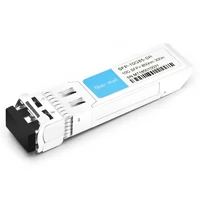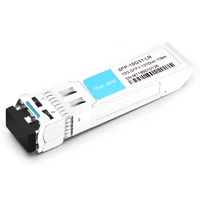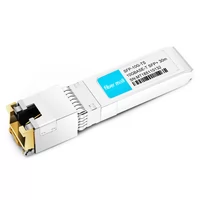In the fast-changing world of networking technology, the Ubiquiti SFP+ transceiver module is an essential part of a network as it helps improve its performance and makes it more flexible. With data transmission optimization becoming a significant goal for many organizations, knowing how these modules work, their specifications, and how they can be used is necessary. This manual provides an all-inclusive description of the Ubiquiti SFP+ transceiver module, including operational principles, compatibility with different devices, and installation procedures. Such information is vital for anyone who wants to upgrade their infrastructure or gain more skills in this kind of technology, whether you are a network expert or just someone interested in learning more about computers.
Table of Contents
ToggleWhat is a Ubiquiti SFP+ Transceiver Module?
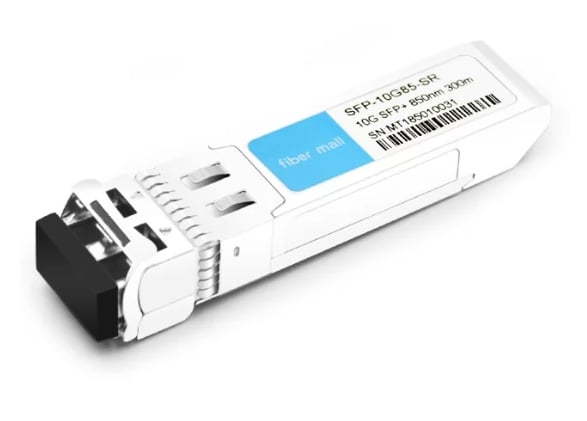
Key Features of Ubiquiti SFP+ Modules
Many key features are built into Ubiquiti SFP+ transceiver modules so they can work better and more efficiently in high-speed networking environments. They support data rates up to 10 Gbps, enabling quick data transfer through different network infrastructures. These modules also have several form factors and distances, such as short-range (SR), long-range (LR), and extended long-range (ER), that can be used for various applications depending on networking needs. Another thing about this module is that it supports a wide range of Ubiquiti devices, so there won’t be any problems with integration or flexibility during deployment. Besides that, these units come equipped with thermal solid management systems that ensure optimal performance and durability under different operating conditions. Thus, versatility, high performance, and compatibility make them the best choice for contemporary networks.
How Does an SFP+ Module Work in a Ubiquiti Network?
Compact transceivers that are hot-swappable – this is what SFP+ modules are. They change the electrical signals to optical ones for a Ubiquiti network. Additionally, they can convert them back again. By linking network devices together at rates of up to 10Gbps, when placed in matching SFP+ ports, these modules communicate with switches or routers. Data transmission distance can be lengthened while still keeping signal integrity by connecting these copper cables or optical fibers to other system components. The fact that bandwidth is optimized and latency reduced using advanced encoding and modulation methods is another reason why these things matter within such continually growing complex architectures like computer networks where everything must always work properly.
Compatibility with Ubiquiti Unifi Switches
Ubiquiti SFP+ modules are fashioned to be in harmony with Ubiquiti Unifi switches, enabling easy integration into current network infrastructures. Such modules are compatible with multiple models of Unifi switches that have SFP+ ports thus making it possible to enhance network capacities efficiently. In Unifi switches, the use of SFP+ modules is essential as it helps boost overall network performance by establishing reliable, fast connections for transmitting data traffic between different devices. Moreover, individuals can mix and match various kinds of these modules depending on where they want them deployed, which gives flexibility in creating effective network environments.
How to Install Ubiquiti SFP+ Modules?
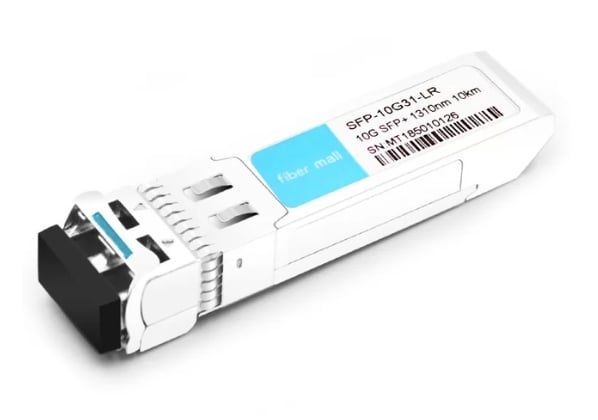
Step-by-Step Installation Guide
- Preparation: Power off the network switch before starting the installation. This will help prevent any potential electrical damage or connectivity issues during the process.
- Locate SFP+ Ports: Find out Ubiquiti Unifi switches’ SFP+ ports. Commonly, these are labeled at the rear or sides of a switch.
- Remove Dust Caps: Eliminate dust caps from both SFP+ module and SFP+ ports cautiously to avoid contamination.
- Insert SFP+ Module: Position your SFP+ module correctly with the port, then gently glide it into a slot until it clicks into place; don’t force it too much, as this can affect its seating.
- Connect Fiber/Copper Cable: Depending on which type of SFP plus transceiver you have used, securely attach the corresponding optical fiber or copper cable to the module.
- Power On The Switch: Turn back the power to the network switch, then allow it to boot up completely.
- Verification: LED indicators on both modules and switches should show that there is indeed a connection between them (blink). Otherwise, accessible logs/user interfaces may also be used for connectivity verification and data transfer rate tests.
- Test Connection: Test whether performance is okay by checking whether data transmission rates match specification requirements and whether network modules work fine within network architecture design principles.
By following these steps, one can ensure efficient and safe installation of Ubiquiti’s SPF+ modules, thereby improving the overall performance of their infrastructure.
Troubleshooting Installation Issues
When you run into problems installing Ubiquiti SFP+ modules, these are some troubleshooting steps to deal with usual issues:
- Compatibility Checking: Make sure the SFP+ module you’re using is compatible with the Ubiquiti Unifi switch model. A list of compatible modules can be found in the Ubiquiti product documentation or on the manufacturer’s website.
- Cable Inspections: Ensure that fiber or copper cables have been accurately connected and firmly seated on both sides of the SFP+ module and its corresponding device. Loose connections may cause signal loss and connectivity problems.
- LED Indicators Checkup: Take a look at the LED indicators on your switch and SFP+ module. If no light comes out or weird patterns are observed, it can mean that either the port, cable, or whole link is faulty. Refer to the user manual for a status explanation of the LEDs.
- Testing Modules in Other Ports: If available, try a different port to determine whether the issue is with a particular port or module itself (this will help narrow down the issue).
- Firmware Update: Always keep your switch firmware up to date. This could fix many related problems, such as compatibility or function issues, related to SFP+ modules.
- Switch Resetting: In case nothing helps and there are still some software-based bugs affecting port functionality, perform a factory reset on the switch (however, don’t forget to back up any configurations before that).
Following these steps, one by one should allow anyone to detect what’s wrong and complete the installation process for ubiquity sfp +modules while ensuring the best network performance.
Best Practices for SFP+ Module Installation
- Use Good Quality Modules at All Times: Always use SFP+ modules from reputable manufacturers or the original equipment manufacturer (OEM) to ensure compatibility and reliability. Do not use poor quality or generic modules, as they can cause performance problems and damage hardware.
- Maintain Correct Handling Procedures: Handle SFP+ modules with care. Never touch connectors directly, and store them in anti-static packaging when not in use. This will prevent any possible electrostatic discharge (ESD) damage.
- Cable Compatibility: Use the correct cabling standards for your SFP+ modules. For example, if optical-designed SFP+ modules are used, then ensure that high-quality fiber optic cables meet necessary specifications, such as OM3 or OM4 for multimode, are used.
- Environmental Monitoring: Ensure the installation environment meets the module manufacturer’s temperature and humidity specifications; excessive heat or moisture may adversely affect module performance levels and shorten their lifespan accordingly.
- Configurations should be Documented: Record all sfp module installations, including model numbers, locations, and configurations – this will make it easier to troubleshoot/maintain network equipment throughout its lifetime.
These best practices will lead to more efficient installation and operation of SFP plus modules, thus improving overall network performance and reliability.
Comparing Ubiquiti SFP+ Modules: Which One to Choose?
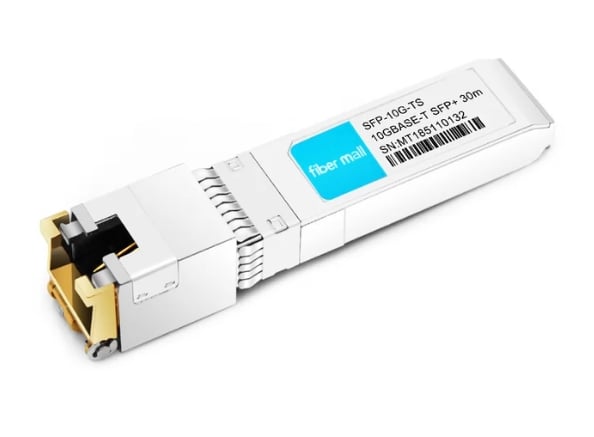
Ubiquiti UF-MM-10G vs. UF-RJ45-10G
The choice between Ubiquiti UF-MM-10G and UF-RJ45-10G SFP+ modules depends on their functions, applications, and performance.
- Ubiquiti UF-MM-10G: This module uses multimode fiber optic connections. It can support a maximum distance of 300 meters (m) with OM3 fiber and 400 meters with OM4 at a wavelength of 850 nm. It works best for short—to medium-range applications commonly located in enterprise networks or data centers.
- Ubiquiti UF-RJ45-10G: Conversely, the UF-RJ45-10G serves copper Ethernet connections exclusively. It allows direct connection through standard twisted-pair cables (Cat6a or higher), thereby enabling transmission up to 100m. This module becomes necessary when using fiber cabling, which is impracticable or too expensive.
In conclusion, one should select either of the two modules according to their network requirements. Choose UF-MM-10G for longer distances within fiber-based networks with higher bandwidth demands, whereas opting for shorter-range, cost-effective ethernet connectivity provided by UF-RJ45-10G.
Understanding 10GBASE-SR and 850nm 300m DOM Transceivers
Intended for 10 Gigabit Ethernet networks, the 10GBASE-SR transceiver is an optical interface that works over short distances and uses multimode fiber up to 300 meters long. These transceivers operate at a wavelength of 850 nm and employ vertical cavity surface emitting laser (VCSEL) technology so as to enable effective communication within data centers and other high-density environments over short distances. “300m DOM” denotes the ability of this type of transceiver equipped with a Digital Optical Monitoring (DOM) feature, which allows it to provide real-time information about such operating parameters as temperature, voltage, or signal strength. Such monitoring features are helpful for troubleshooting purposes thereby improving reliability and efficiency in network maintenance while also enhancing performance levels. When choosing a transceiver, one should take into account various factors about their network, such as distance requirements, bandwidth needs, or cable types used, hence ensuring compatibility as well as achieving optimal results.
Multi-Mode vs. Single-Mode SFP+ Modules
When you compare single-mode SFP+ modules to multi-mode SFP+ modules, a few main differences come out, and these are important for network planning and deployment. Commonly, multi-mode SFP+ transceivers are used in short-distance applications that employ a core diameter of 50 or 62.5 micrometers multi-mode fiber optic cables. These modules can transmit data up to 400 meters which makes them perfect for setting up data centers or building networks. On the other hand single mode SFP+ module utilizes smaller core diameters (approximately 9 micrometers) designed for long haul communication able to reach over distances of up to 80 kilometers depending on the specific module and fiber type used.
The major benefit of using Multi-Mode is its affordability and simplicity in an implementation where high bandwidth is required but over a limited range. However, Single-Mode wins regarding greater bandwidths and much lower attenuations per unit length hence higher signal quality over longer links. In conclusion, one should consider factors such as distance requirements between networks and budget constraints, among others, before choosing whether to use multi-mode or single-mode SFP plus modules in their system design.
Customer Reviews and Real-World Performance
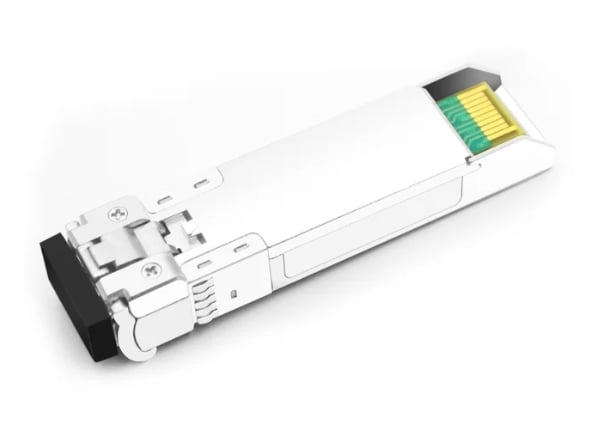
Common Feedback on Ubiquiti SFP+ Modules
Commonly referred to as reliable and performant in a variety of networking environments are ubiquiti sfp+ modules. People like me have found them very easy to integrate with other ubiquiti devices because they are competitively priced hence this does not affect quality even a little bit, according to certain reviewers. Another thing that most customers mention about these units is the fact that they offer great value for money when compared to their rivals.
Broadband-intensive applications can be supported by ubiquity sfp+ module since it has been discovered through performance feedback that data transfer speeds are always maintained at high levels. At the same time, latency remains low throughout usages involving large bandwidth. Nonetheless, some wish there was better documentation and support, especially during user troubleshooting situations. The bottom line from what I have read so far is that the majority of individuals believe investing in Ubiquiti SFP Plus Modules is worthwhile either for personal or business use, where one might want fast speeds coupled with reliability without necessarily having to pay exorbitant amounts of money.
Performance Metrics: Speed and Reliability
When assessing the performance of Ubiquiti SFP+ modules, two main components are usually considered—reliability and speed. Speed is typically measured in terms of data transfer rates, which can be as high as 10 Gbps for these modules under perfect conditions. This fast rate is vital for systems that require a lot of bandwidth, such as interconnection between data centers or streaming high-definition videos.
On the other hand, stability helps to ensure that networks always work uniformly well. Designed tough with muscular builds and hardiness against different operational environments, it is not surprising why feedback shows minimal signal deterioration in these gadgets even over long distances, thus guaranteeing continued output. Additionally, advanced temperature control features have been added so that they can operate within their best temperatures, hence reducing the chances of overheating and failure.
To summarize, ubiquity SFP plus transceivers are known for their high speeds and reliability across various networking contexts, making them suitable for people who want dependable network solutions that work efficiently.
Quality Testing and Warranty Information
Ubiquiti SFP+ modules are thoroughly tested to meet industry standards for quality, reliability, and performance. Standard tests include but are not limited to, checking whether the data transmission rate is met and whether the module can withstand different environmental conditions, among other things. These assessments should ideally replicate real-life scenarios to ensure the universal applicability of these devices.
As far as warranty is concerned with Ubiquiti, an essential warranty period covers defects due to materials and workmanship errors. The typical duration for this cover is usually 2 years which shows that they have confidence in their products’ durability and reliability levels. To enjoy warranty support, it is recommended that one registers his/her product(s) because doing so makes it easy to process claims. They also have good customer care services coupled with quick response time, further indicating their commitment to keeping clients satisfied, thus assuring those who invest in networking solutions peace of mind.
Frequently Asked Questions (FAQs) About Ubiquiti SFP+ Modules
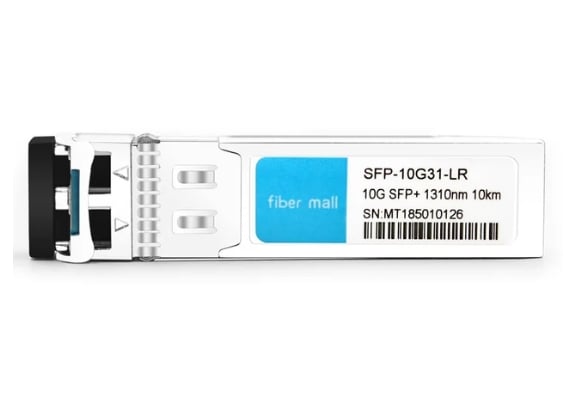
What Cables Are Compatible with Ubiquiti SFP+ Modules?
Ubiquiti SFP+ modules are designed to work with many different types of cables, including copper and optical. In terms of optical connections, Ubiquiti usually works with multimode or single-mode fiber cables. The recommended cable for short-distance applications is OM3 or OM4 multimode fiber cable, while a long-haul single-mode fiber cable can go over 10 km, depending on the module being used.
When it comes to copper connections, these devices most commonly use 10GBASE-T cables, which are standard Ethernet cables made out of copper that can support up to 100m over Cat6 or higher cabling. You should always make sure your chosen cable meets the specifications for the specific SFP+ module being used so as not to compromise performance or reliability in different networking environments.
Can I Use Ubiquiti SFP+ Modules with Non-Ubiquiti Equipment?
Certainly, non-Ubiquiti equipment can use Ubiquiti SFP+ modules as long as both the networking device and the SFP+ module conform to the standards for SFP+. Most manufacturers follow these standards, so they should work with third-party switches and routers. Nevertheless, it is important to recognize that some features or functions might not be supported by specific non-ubiquitous devices when using third-party sfp plus modules. To get the best performance and warranty compliance, you must check specific compatibility in line with the manufacturer’s documentation. Generally speaking, people have had success using them across different brands, which increases flexibility and choice when designing networks.
How to Identify a Genuine Ubiquiti SFP+ Module?
There are some easy ways to recognize an original Ubiquiti SFP+ module. The first thing you should do is check the packaging. Genuine Ubiquiti items usually come in high-quality branded packages with security seals. Second, inspect the module itself for accurate printing on the label that includes the Ubiquiti logo, serial number, and part number — these should be legible and not smeared or blurred.
Next, confirm if this module will work with your gear by reviewing specifications at their official site or user manuals. In many cases, real modules have firmware that can be updated via UniFi or EdgeMAX management systems from Ubiquiti, thereby providing ongoing support and functionality. Finally, buy through reputable distributors or directly from them because counterfeits are less likely to exist due to more authentic equipment being sold, which meets the company’s strict quality criteria.
Reference Sources
Frequently Asked Questions (FAQs)
Q: What is an SFP+ transceiver module?
A: An SFP+ transceiver module is a compact optical transmitter-receiver that is hot-pluggable and used for data communication and telecommunication applications. It can support data rates up to 10Gbps.
Q: Can all switches be used with an SFP+ transceiver module?
A: There may be compatibility issues depending on the switch’s model and brand. Many brands, such as Cisco and Ubiquiti, can use SFP+, but it is always better to check the manufacturer’s specifications for confirmation.
Q: What are the available types of SFP+ transceiver modules?
A: Some types of these modules include 10GBASE-SR (short-range), 10GBASE-LR (long-range), and 10GBASE-T (copper-based over standard Ethernet cables).
Q: How do you connect an SFP+ module to a network?
A: A network connects through an SFP+ port, which is found on various devices like routers, switches, or firewalls. These modules typically use fiber optic cables with LC connectors or Ethernet cables with RJ45 connectors.
Q: What’s the difference between single-mode and multimode SFP+ modules?
A: Single-mode SFP + modules are designed for long-distance data transmission using one optical fiber, while multimode ones, like the MMF transceiver module, are meant for shorter distances using multiple optical fiber modes.
Q: What is the scope of a 10km DOM transceiver module with a 1310nm wavelength?
A: A 10-kilometer distance can be covered by the data transmission range of the 1310-nanometer (10km) DOM transceiver module.
Q: Can I use the SFP module with Ubiquiti UDM Pro?
A: Yes, SFP modules are supported by Ubiquiti UDM Pro, which allows for various networking options, such as fiber optic and Ethernet connections.
Q: What is DAC cable, and how does it relate to SFP+ modules?
A: A Direct Attach Copper (DAC) cable is a high-speed cable with integrated SFP+ transceivers on both ends. It is mainly used for short-distance connections within racks or between close network switches.
Q: What is Cisco SFP-10G-T-S and what is its use case?
A: Cisco SFP-10G-T-S is a 10GBASE-T SFP+ transceiver module for copper cabling-based 10Gbps Ethernet connections. It is best suited when connecting network devices in the data center environment.
Q: How do I choose the suitable SFP+ module for my network?
A: When choosing an appropriate SFP+ module for your network, you should consider factors such as the required data rate (e.g., 10Gbps), the distance of connection (e.g., short-haul or long-haul), the type of cable (e.g., fiber-optic or Ethernet), and compatibility with your network equipment.

